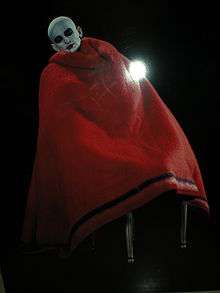Harpya
| Harpya | |
|---|---|
| Directed by | Raoul Servais |
| Written by | Raoul Servais |
| Starring |
Will Spoor Fran Waller Zeper Sjoert Schwibethus |
| Music by | Lucien Goethals |
| Cinematography |
Raoul Servais (animation) Walter Smets |
Release dates |
|
Running time | 9 minutes |
| Country | Belgium |
| Language | None |
Harpya is a 1979 short Belgian animated film written and directed by Raoul Servais. It stars Will Spoor, Fran Waller Zeper and Sjoert Schwibethus. The film won the Palme d'Or for Best Short Film at the 1979 Cannes Film Festival. Its mix of horror and black comedy has given it a cult following.[1]
Production
Servais animated the film using 35mm color front-projection of his characters onto a multiplane filmed, black velvet background.

Synopsis
A mustachioed Belle Époque-styled man (Spoor) is walking down a dark street, when he hears the cries of a woman (Waller Zeper) as she is being strangled in a fountain. The man knocks out her assailant (Schwibethus), only to discover that she is in fact a Harpy, a winged white bird, larger than an eagle, having the (bald) head and breasts of a woman. Fascinated, the man takes the beast to his home to shelter and feed it. He soon discovers the Harpy's insatiable appetite. The Harpy eats all his food, then eats his parrot, and begins eyeing her host with a sinister stare. One night, when the man attempts to escape, the Harpy overwhelms him and eats his legs.
Later, once the Harpy is asleep, the man crawls out of his house, joyfully finding French fries to eat. The Harpy flies out of the house and discovers him, eating his snack. The desperate, enraged man then attempts to strangle her. Upon hearing her cries, a police officer comes to the rescue and saves the would-be "victim", knocking the man to the ground; the Harpy then looks up at the officer in glee.
Interpretation & Themes
The Harpy, with its human torso and facial features, can be aligned to Freud's primal uncanny and Kristeva's notion of the abject in cinema. The film can also be read as a modern retelling of the femme fatale archetype story - a warning to men captivated by the allure of a dangerous female.
Awards
- Palme d'Or for Best Short Film 1979
See also
References
External links
- Harpya at the Internet Movie Database
- Harpya at AllMovie
